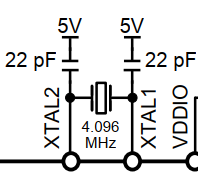Other Parts Discussed in Thread: ADS1292, ADS1298
Hi,
1. In the ADS1293 EVM the crystal circuit is shown as under
The crystal seems to be connected to AVDD and AGND, its generally the case that high frequency signals are connected to DVDD and DGND while the analog part is kept as quite as possible. So is this an error in the schematic?
2. The crystal oscillator circuit is different in the EVM and in the datasheet.
Which is the correct one. I'm attaching the snapshot from the datasheet since the EVM schematic is already shown above. (Although I must say even in the datasheet AVDD seems to be connected to the crystal)
3. The shield is generally driven with another op-amp via the RLD circuit. However the ADS1293 datasheet says that the CMOUT can be used as a shield drive. Do we still need an op-amp at the output of the CMOUT pin or can the CMOUT directly drive the shield?



